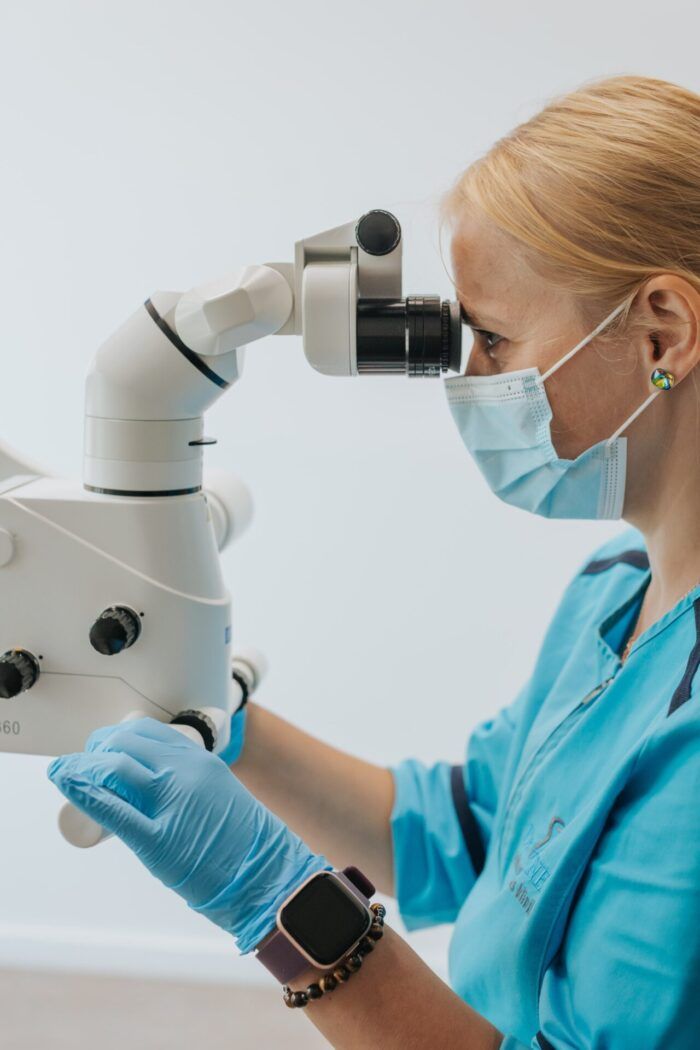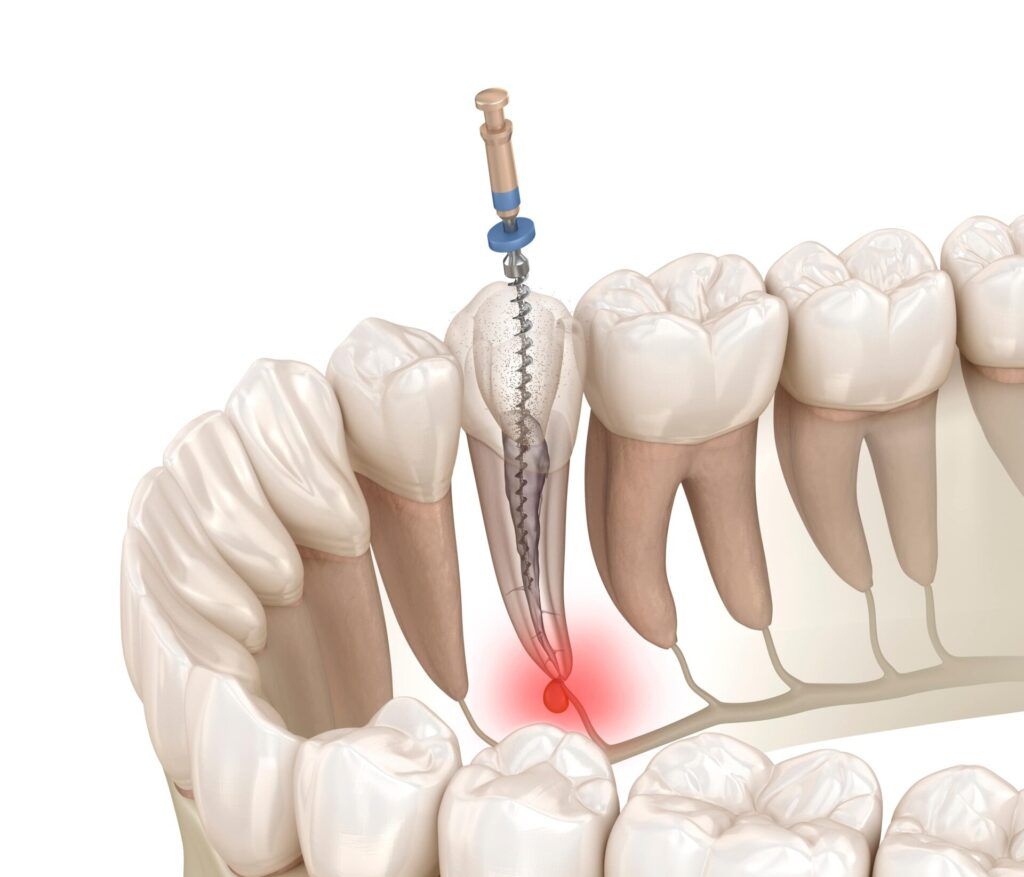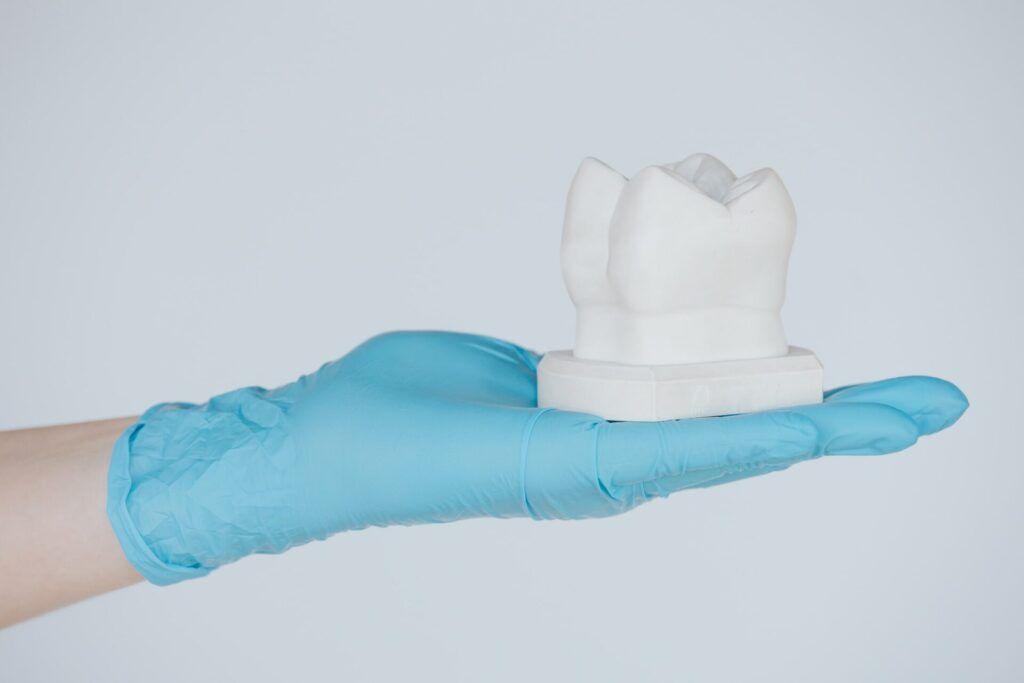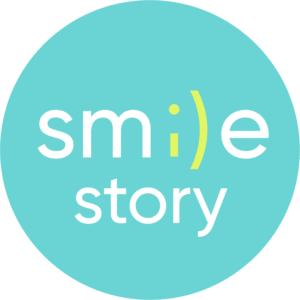
Dental treatment

Filling
Filling is a dental treatment procedure during which the decayed part of a tooth is filled with the filling material.
The filling material is to be chosen for each clinical situation. Nowadays the most often used material is composite or a white helium filling. Such a filling is chemically bonded to the tooth tissues owing to a special bonding system; it features high durability and allows aesthetical adjustment to any tooth colour even though it shrinks a little while hardening. Although the physical properties of composite fillings have significantly improved these days, still their use is not advisable if more than 50% of the tooth tissues have been lost. In such cases use of onlays or crowns is preferable. An onlay is a lab-developed ceramic filling of a higher durability and no polymerisation shrink that often cause dental fracture.
Procedure description
- If needed the dental anaesthesia is applied to prevent any pain in the area.
- By a dental handpiece having a drill fixed in its tip the decayed tissues are mechanically removed. First a high-speed rotating instrument or a turbine is used by which the decayed and carious cover enamel is removed.
- As dentin is softer that enamel, the mass of the decayed tissues must be removed in a more careful way, and a slow-speed rotating instrument – a micromotor – is used. By this drill the damage is removed leaving the healthy tissues untouched so that a filling may be placed and a new damage may not occur soon.
- In cases of deeper damages a liner is put in that protects the tooth pulp from thermal and chemical damage.
- The tooth filling is bonded to the tooth by a special bonding system (gel between the tooth and the filling) that is layered in the tooth cavity and shined by a special halogen or LED lamp used in dentistry.
- Then the cavity gets filled with the filling material that is hardened by applying a LED or halogen lamp.
- At the end the tooth filling gets adjusted to the occlusion and burred.
Dental restoration with a tooth onlay
- If needed the dental anaesthesia is applied to prevent any pain in the area.
- By a dental handpiece having a drill fixed in its tip the decayed tissues are mechanically removed. First a high-speed rotating instrument or a turbine is used by which the decayed and carious cover enamel is removed.
- As dentin is softer that enamel, the mass of the decayed tissues must be removed in a more careful way, and a slow-speed rotating instrument – a micromotor – is used. By this drill the damage is removed leaving the healthy tissues untouched so that a filling may be placed and a new damage may not occur soon.
- In cases of deeper damages a liner is put in that protects the tooth pulp from thermal and chemical damage.
- An imprint is prepared in special imprint material that is to be sent to the laboratory.
- The tooth gets filled with a temporary filling.
- In the following session the temporary filling is to be removed.
- Special gel is applied to the surface of the tooth to disinfect, clean and prepare it.
- A dental onlay is bonded to the tooth by a special type of cement.

Canal treatment
Endodontics or dental root canal treatment is applied if due to the tooth defect the soft tissues – nerves and blood vessels located in the tooth canal – of the tooth have been damaged. The defect results in pulp inflammation that may cause pain and temperature change, acute pain, pain during sleep. Unless the damage gets treated the chronic phase of inflammation starts – from the dental canals to the jawbone. The endodontic procedure is performed in order to clean the tooth canals of bacteria thereby renovate the tooth and prevent its extraction.
Endodontics is a continuous and difficult procedure still often it is the only possibility to preserve the tooth. The number of the sessions depends on the amount of canals and anatomy of the tooth, difficulty of the procedure and spread of the inflammation. If the infection has not spread to the jawbone, the treatment may take on visit only, but a larger number of canals, focal of infection in the jawbone, necessity of retreatment normally require two and more visits.
Procedure description
- If needed the dental anaesthesia is applied to prevent any pain in the area.
- The carious masses and tooth tissues are removed to reach the tooth canal.
- The tooth canal gets processed and widened by special instruments.
- The tooth canal is chemically processed so that all the bacteria are killed and the infectious tooth masses are rinsed out.
- If the infection has not developed in the jawbone (it may be observed by x-rays), the tooth canal can be filled with special material – gutta-percha. The tooth canal treatment is completed, and the tooth crown can be handed to further renovation.
- In case infection has developed in the jawbone, special disinfecting medicine is placed in the tooth canal. The tooth gets filled with a temporary filling.
During the following session the temporary filling is to be removed, the canal receives repeated processing and rinse, it is filled with gutta-percha and endodontic treatment of the tooth is completed. The crown part of the tooth is to be sealed with the filling material and prosthetics is performed if needed.

Cosmetic tooth filling
Not satisfied with the aesthetics of your incisive teeth? One of the ways how to improve the incisive aesthetics is the cosmetic filling of the teeth. The incisive teeth aesthetics may be renovated by using teeth fillings in cases when a tooth has lost part of its edge, its colour has changed, it has cracked or get coloured along the filling rims, or erosion has occurred at the tooth neck. The tooth filling facets are shaped by covering the visible part of a tooth with filling material thereby structuring an aesthetical tooth of natural colour and shape. When tooth facets are made, the shape of a tooth may be easily changed as well as any corrections if needed are easily possible.
Procedure description
- Before a patients decides in favour of covering the tooth facets with the filling material we suggest performing replacement of the current fillings first. If the fillings are not very big they can be replaced when shaping the facets.
- If necessary, the tooth tissues are partially removed if they impede shaping an even dental arch.
- The filling is to be glued in very thin layers by providing a natural blend of the tooth colouring.
- The new tooth gets burred until the needed shape and gloss are obtained.
Recommendation!
- If you are planning to get tooth facets, do not forget to reserve a visit for correction as well.
- The filling facets are not as durable as porcelain plates so the fillings will possibly need correction or burring occasionally.
Prices
Dental and canal treatment
Composite filling on one tooth side (small hole)
Composite filling on two tooth sides (medium hole)
Composite filling on three tooth sides (large hole)
Composite filling on four tooth sides (large hole)
Preparation of single-channel tooth
Preparation of two-channel tooth
Preparation of three-channel tooth
Preparation of four-channel tooth
Filling of single-channel tooth
Filling of two-channel tooth
Filling of three-channel tooth
Filling of four-channel tooth
Root canal re-treatment
Anesthesia
Wand STA anesthetic
Intraoral dental X-ray
Sedation with “laughing gas”





